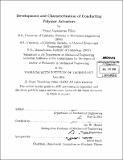Development and characterization of conducting polymer actuators
Author(s)
Pillai, Priam Vasudevan
DownloadFull printable version (18.13Mb)
Other Contributors
Massachusetts Institute of Technology. Dept. of Mechanical Engineering.
Advisor
Ian W. Hunter.
Terms of use
Metadata
Show full item recordAbstract
Conducting polymers such as polypyrrole, polythiophene and polyaniline are currently studied as novel biologically inspired actuators. The actuation mechanism of these materials depends upon the motion of ions in and out of the polymer film during electrochemical cycling. The diffusion of ions into the bulk of the film causes the dynamic mechanical and electrical properties of the material to change during oxidation and reduction. The mechanism of this change is not fully understood, as it can depend on many different factors such as oxidation state, solvation of the film and the level of counter ion swelling. In-situ measurement of the dynamic mechanical compliance and electrical impedance of polypyrrole as a function of charge is difficult, since the compliance depends upon the excitation frequency as well as the electrochemical stimulus. Here, we have developed novel experimental techniques that use stochastic input waveforms to dynamically measure the compliance and impedance response of conducting polymers as a function of frequency and an electrochemical stimulus. A stochastic stress input signal with a bandwidth of 30 Hz is used, which allows us to compute the mechanical compliance transfer function of polypyrrole as function of the electrochemistry. The low frequency compliance changes between 50-80%, as charge is injected into polypyrrole in neat 1-butyl-3-methylimidazolium hexafluorophosphate. The compliance changes reversibly as ions diffuse in and out of the film, which indicates that the compliance depends upon the level of counter ion swelling. The effect of cationic and anionic charging on the polypyrrole compliance is demonstrated in multiple ionic/solvent combinations. The stochastic signals are also used to the characterize the isometric and isotonic responses of conducting polymer actuators. This technique is used to demonstrate the effect of temperature and solution conductivity on actuation and to develop methods that can be used to improve polymer actuator performance. Efficient techniques to incorporate functionalized carbon nanotubes into conducting polymers using layer by layer deposition and drop casting methods have been explored. These new composite materials and techniques significantly reduce creep, improve conductivity and increase stiffness of the polymer actuators.
Description
Thesis (Ph. D.)--Massachusetts Institute of Technology, Dept. of Mechanical Engineering, 2011. Cataloged from PDF version of thesis. Includes bibliographical references (p. 115-127).
Date issued
2011Department
Massachusetts Institute of Technology. Department of Mechanical EngineeringPublisher
Massachusetts Institute of Technology
Keywords
Mechanical Engineering.